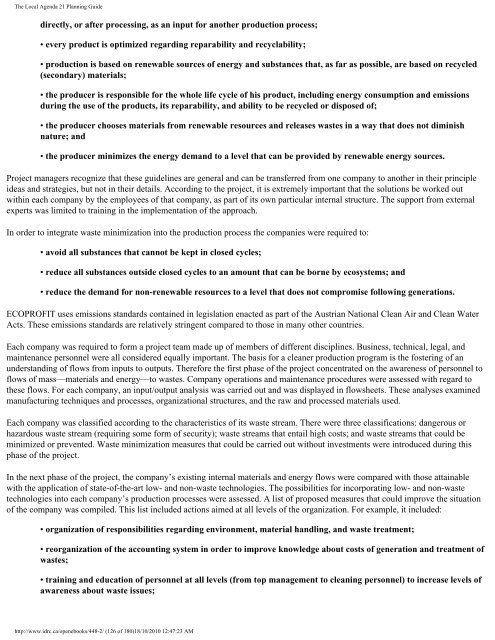The Local Agenda 21 Planning Guide - Democrats Against UN ...
The Local Agenda 21 Planning Guide - Democrats Against UN ...
The Local Agenda 21 Planning Guide - Democrats Against UN ...
You also want an ePaper? Increase the reach of your titles
YUMPU automatically turns print PDFs into web optimized ePapers that Google loves.
<strong>The</strong> <strong>Local</strong> <strong>Agenda</strong> <strong>21</strong> <strong>Planning</strong> <strong>Guide</strong><br />
directly, or after processing, as an input for another production process;<br />
• every product is optimized regarding reparability and recyclability;<br />
• production is based on renewable sources of energy and substances that, as far as possible, are based on recycled<br />
(secondary) materials;<br />
• the producer is responsible for the whole life cycle of his product, including energy consumption and emissions<br />
during the use of the products, its reparability, and ability to be recycled or disposed of;<br />
• the producer chooses materials from renewable resources and releases wastes in a way that does not diminish<br />
nature; and<br />
• the producer minimizes the energy demand to a level that can be provided by renewable energy sources.<br />
Project managers recognize that these guidelines are general and can be transferred from one company to another in their principle<br />
ideas and strategies, but not in their details. According to the project, it is extremely important that the solutions be worked out<br />
within each company by the employees of that company, as part of its own particular internal structure. <strong>The</strong> support from external<br />
experts was limited to training in the implementation of the approach.<br />
In order to integrate waste minimization into the production process the companies were required to:<br />
• avoid all substances that cannot be kept in closed cycles;<br />
• reduce all substances outside closed cycles to an amount that can be borne by ecosystems; and<br />
• reduce the demand for non-renewable resources to a level that does not compromise following generations.<br />
ECOPROFIT uses emissions standards contained in legislation enacted as part of the Austrian National Clean Air and Clean Water<br />
Acts. <strong>The</strong>se emissions standards are relatively stringent compared to those in many other countries.<br />
Each company was required to form a project team made up of members of different disciplines. Business, technical, legal, and<br />
maintenance personnel were all considered equally important. <strong>The</strong> basis for a cleaner production program is the fostering of an<br />
understanding of flows from inputs to outputs. <strong>The</strong>refore the first phase of the project concentrated on the awareness of personnel to<br />
flows of mass—materials and energy—to wastes. Company operations and maintenance procedures were assessed with regard to<br />
these flows. For each company, an input/output analysis was carried out and was displayed in flowsheets. <strong>The</strong>se analyses examined<br />
manufacturing techniques and processes, organizational structures, and the raw and processed materials used.<br />
Each company was classified according to the characteristics of its waste stream. <strong>The</strong>re were three classifications: dangerous or<br />
hazardous waste stream (requiring some form of security); waste streams that entail high costs; and waste streams that could be<br />
minimized or prevented. Waste minimization measures that could be carried out without investments were introduced during this<br />
phase of the project.<br />
In the next phase of the project, the company’s existing internal materials and energy flows were compared with those attainable<br />
with the application of state-of-the-art low- and non-waste technologies. <strong>The</strong> possibilities for incorporating low- and non-waste<br />
technologies into each company’s production processes were assessed. A list of proposed measures that could improve the situation<br />
of the company was compiled. This list included actions aimed at all levels of the organization. For example, it included:<br />
• organization of responsibilities regarding environment, material handling, and waste treatment;<br />
• reorganization of the accounting system in order to improve knowledge about costs of generation and treatment of<br />
wastes;<br />
• training and education of personnel at all levels (from top management to cleaning personnel) to increase levels of<br />
awareness about waste issues;<br />
http://www.idrc.ca/openebooks/448-2/ (126 of 180)18/10/2010 12:47:23 AM










